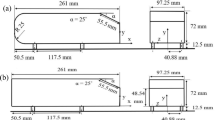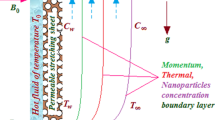Abstract
This paper is a research on the variation character of stagnation point heat flux for hypersonic pointed bodies from continuum to rarefied flow states by using theoretical analysis and numerical simulation methods. The newly developed near space hypersonic cruise vehicles have sharp noses and wingtips, which desires exact and relatively simple methods to estimate the stagnation point heat flux. With the decrease of the curvature radius of the leading edge, the flow becomes rarefied gradually, and viscous interaction effects and rarefied gas effects come forth successively, which results in that the classical Fay-Riddell equation under continuum hypothesis will become invalid and the variation of stagnation point heat flux is characterized by a new trend. The heat flux approaches the free molecular flow limit instead of an infinite value when the curvature radius of the leading edge tends to 0. The physical mechanism behind this phenomenon remains in need of theoretical study. Firstly, due to the fact that the whole flow regime can be described by Boltzmann equation, the continuum and rarefied flow are analyzed under a uniform framework. A relationship is established between the molecular collision insufficiency in rarefied flow and the failure of Fourier’s heat conduction law along with the increasing significance of the nonlinear heat flux. Then based on an inspiration drew from Burnett approximation, control factors are grasped and a specific heat flux expression containing the nonlinear term is designed in the stagnation region of hypersonic leading edge. Together with flow pattern analysis, the ratio of nonlinear to linear heat flux W r is theoretically obtained as a parameter which reflects the influence of nonlinear factors, i.e. a criterion to classify the hypersonic rarefied flows. Ultimately, based on the characteristic parameter W r , a bridge function with physical background is constructed, which predicts comparative reasonable results in coincidence well with DSMC and experimental data in the whole flow regime.
Similar content being viewed by others
References
Reuther J, Kinney D, Smith S, et al. A reusable space vehicle design study exploring sharp leading edges. AIAA 2001–2884
Walker S P, Sullivan B J. Sharp refractory composite leading edges on hypersonic vehicles. AIAA 2003–6915
Fay J A, Riddell F R. Theory of stagnation point heat transfer in dissociated air. J Aeronaut Sci, 1958, 25(2): 73–85
Kao H C. Hypersonic viscous flow near the stagnation streamline of a blunt body: II. Third-Order Boundary-Layer theory and comparison with other methods. AIAA J, 1964, 2(11): 1898–1906
Paul K. Aerothermal Performance constraints for hypervelocity small radius unswept leading edges and nosetips. NASA Technical Memorandum 112204, 1997
Boyd I D, Chen G. Predicting failure of the continuum fluid equations in transitional hypersonic flows. Phys Fluids, 1995, 7(1): 210–219
Lofthouse J, Boyd I D, Wright M J, et al. Effects of continuum breakdown on hypersonic aerothermodynamics. AIAA 2006–993
Michael N M. Scaling parameters in rarefied flow and the breakdown of the Navier-Stokes equations. Department Technical Report, Department of Mechanical Engineering, School of Engineering, The University of Queensland. 2004
Mikhailov V V, Neiland V Y, Sychev V V, et al. The theory of viscous hypersonic flow. Annu Rev Fluid Mech, 1971, 3: 371–396
Cheng H K. Perspectives on hypersonic viscous flow research. Annu Rev Fluid Mech, 1993, 25: 455–484
Cheng H K. The blunt-body problem in hypersonic flow at low Reynolds number. Cornell Aeronautical Laboratory Report No. AF-1285-A-10. June 1963
Engel C D, Praharaj S C. Minnver Upgrade For the AVID System (Volume 1: LANMIN User’s Manual). NASA Contractor Report 172212: 126. 1983
Tsien H S. Superaerodynamics, mechanics of rarefied gases. J Aeronaut Sci, 1946, 13: 653–664
Nomura S. Correlation of hypersonic stagnation point heat transfer at low Reynolds numbers. AIAA J, 1982, 21(11): 1598–1600
Lips T, Fritsche B. A comparison of commonly used re-entry analysis tools. Acta Astronaut, 2005, 57: 312–323
Tannehill J C, Eisler G R. Numerical computation of the hypersonic leading edge problem using Burnett equations. Phys Fluid, 1975, 19(1): 9–15
Zhong X, Furumoto G. Solutions of the Burnett equations for axisymmetric hypersonic flow past spherical blunt bodies. AIAA 1994–1959
Bird G A. Molecular Gas Dynamics and the Direct Simulation of Gas Flows. Oxford: Oxford University Press, 1994
Lofthouse A J. Nonequilibrium hypersonic aerothermodynamics using the Direct Simulation Monte Carlo and Navier-Stokes models. Doctor Dissertation. Michigan: University of Michigan, 2008
Chapman S, Cowling T G. The Mathematical Theory of Non-uniform Gases. 3rd ed. Cambridge: Cambridge University Press, 1970
Matting F W. General solution of the laminar compressible boundary layer in the stagnation region of blunt bodies in axisymmetric flow. NASA Technical Note, D-2234, 1964
Riabov V V. Numerical simulation of kinetic effects in low-density hypersonic aerodynamics. Rivier Acad J, 2006, 2(2): 1–17
Author information
Authors and Affiliations
Corresponding author
Additional information
Supported by the National Natural Science Foundation of China (Grant No. 90716011)
Contributed by TONG BingGang
Rights and permissions
About this article
Cite this article
Wang, Z., Bao, L. & Tong, B. Variation character of stagnation point heat flux for hypersonic pointed bodies from continuum to rarefied flow states and its bridge function study. Sci. China Ser. G-Phys. Mech. Astron. 52, 2007–2015 (2009). https://doi.org/10.1007/s11433-009-0226-7
Received:
Accepted:
Published:
Issue Date:
DOI: https://doi.org/10.1007/s11433-009-0226-7




